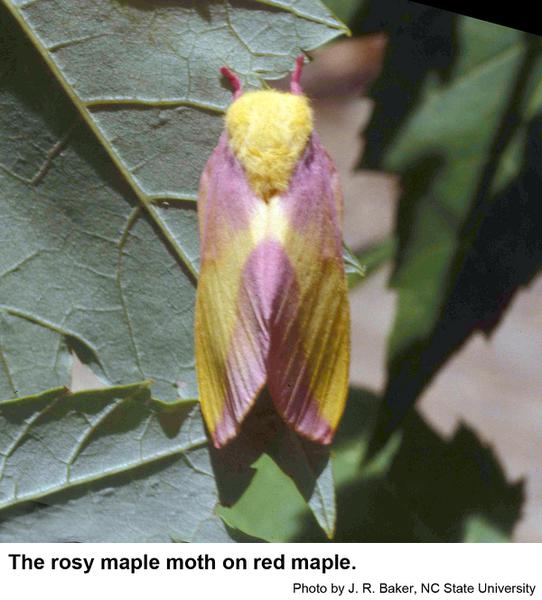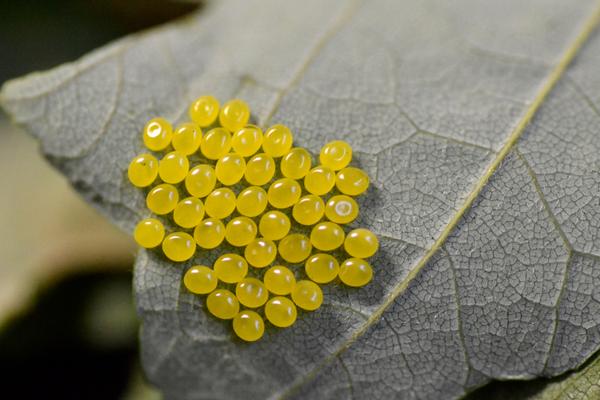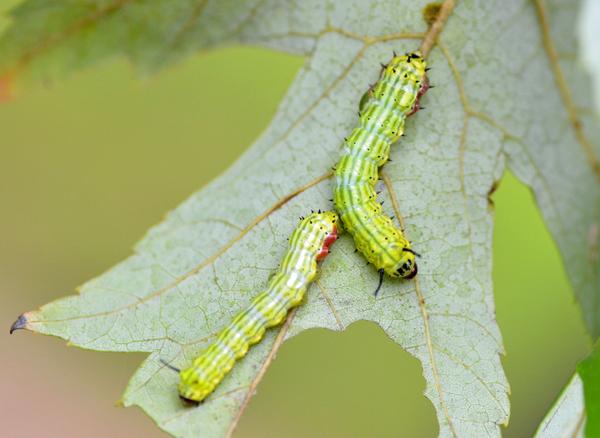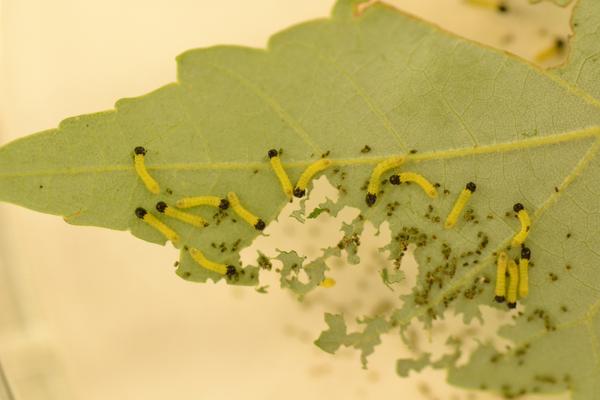Identification and Damage
The greenstriped mapleworm, Dryocampa rubicunda, is found throughout the Eastern United States and Canada. Maples are its preferred hosts and the most common hosts in many landscapes. Some oaks can also be damaged especially when in close proximity to maples.
In North Carolina, moths emerge from their pupae in late April or early May. They are commonly known as the rosy maple moth. The body of the moth is yellow on top and pink on the bottom with wings exhibiting yellow and pink colorations that vary in design. The moths deposit yellow eggs on the underside of leaves. The larvae have red or black heads, pale-green bodies with seven dark-green longitudinal stripes. There are two prominent horns on the second thoracic segment, two rows of short spines on the side of the body, and four larger spines on the terminal abdominal segments. Full-grown larvae can reach 40 mm in length. Adult moths can have a wingspan of 37 to 50 mm.
Larvae are the only herbivorous life stage, capable of devouring several entire leaves per caterpillar. Large populations of mapleworms can defoliate trees if unnoticed or without proper management. Rarely will the tree suffer long term damage but loss in growth and branch dieback may occur if the same tree is defoliated several consecutive years. Older literature refers to episodes in which the first generation strips maples bare, and then just as a new flush of growth emerges, the second generation emerges to defoliate the trees again. This type of defoliation can seriously weaken maples to the point that borers and fungi may infest the trees and finish them off.
Biology
Rosy maple moths lay eggs on the underside of leaves on the outer edge of the tree canopy from May to June in North Carolina. These eggs hatch in approximately 10 days, releasing ravenous caterpillars into the tree canopy. Mapleworm larvae feed on tree foliage from the time of emergence until they are able to pupate. Larvae feed in aggregates up until the third instar at which point they begin to feed individually. After about one month the larvae crawl to the ground to pupate. In the southern United States, adults will emerge in about two weeks and begin the second generation of the year. Up to three generations may occur in the southern United States but only one generation occurs in the northern United States and Canada. Mapleworm pupa overwinter in the soil typically under a host tree.
Scouting and Monitoring
Periodically examining the underside of several leaves per tree from May through June for egg masses and removing those leaves or destroying the eggs can help reduce tree damage. Surveying tree canopies for leaf defoliation is one of the best ways to catch an infestation after egg hatch. Examining a tree canopy from a distance where the entire tree is in view can help identify patches of infestation where there are bare branches whose leaves have been eaten. Caterpillars will generally be found feeding on leaf margins eating towards the midvein. If one caterpillar is found, there are likely many others on the same tree. Look for frass on the ground beneath trees.
Decision Making
There are no established aesthetic or damage thresholds for greenstriped mapleworm. Populations can become large enough to defoliate trees but this is rare. Frass on patios and decks can be a reason some people seek intervention.
Intervention
Cultural Control
Reducing plant stress by proper planting and watering may reduce susceptibility to pest infestations. However, excessive fertilizer may increase pest abundance by making trees more nutritious to pests and reducing the trees’ natural defenses.
Mechanical Control
If clusters of yellow eggs are found, scrape them off or remove the entire leaf to reduce the caterpillar population. Since the caterpillars feed in groups, often a single branch is infested that can be pruned.
Biological Control
The greenstriped mapleworm has several natural enemies but none have been recorded in great abundance. Studies have shown that less than 10% of larvae will be parasitized in natural populations. Other predators such as birds may also provide some biological control.
Chemical Control
If chemical control is necessary, Chlorantraniliprole (Acelepryn) can provide effective foliar and systemic control while having a relatively low impact on non-target organisms. Bacillus thuringiensis (bt) and spinosad are also among the insecticides for caterpillar control with low impact on non-target organisms. Broad-spectrum insecticides like pyrethroids and acephate are not recommended because they will also kill beneficial insects. See complete list of labeled insecticides in the North Carolina Agricultural Chemicals Manual.
References
- Biology, Injury, and Management of Maple Tree Pests in Nurseries and Urban Landscapes. S. D. Frank, S. D., W. E. Klingeman, III, S. A. White, and A. Fulcher. 2013. Journal of Integrated Pest Managment. 4(1): 1-14.
- Greenstriped Mapleworm. Hale, F. A. and J. Yanes Jr. Undated. Insects. SP290-Y. Univ Tennessee Extension.
- The Green-Striped Maple Worm. Howard, L. O. and F. H. Chittenden. 1909. USDA, Bureau of Entomology. Circular 110, 7 pp.
- Extension Plant Pathology Publications and Factsheets
- Horticultural Science Publications
- North Carolina Agricultural Chemicals Manual
For assistance with a specific problem, contact your local N.C. Cooperative Extension Center
Publication date: July 3, 2015
Reviewed/Revised: Sept. 20, 2019
Recommendations for the use of agricultural chemicals are included in this publication as a convenience to the reader. The use of brand names and any mention or listing of commercial products or services in this publication does not imply endorsement by NC State University or N.C. A&T State University nor discrimination against similar products or services not mentioned. Individuals who use agricultural chemicals are responsible for ensuring that the intended use complies with current regulations and conforms to the product label. Be sure to obtain current information about usage regulations and examine a current product label before applying any chemical. For assistance, contact your local N.C. Cooperative Extension county center.
N.C. Cooperative Extension prohibits discrimination and harassment regardless of age, color, disability, family and marital status, gender identity, national origin, political beliefs, race, religion, sex (including pregnancy), sexual orientation and veteran status.







